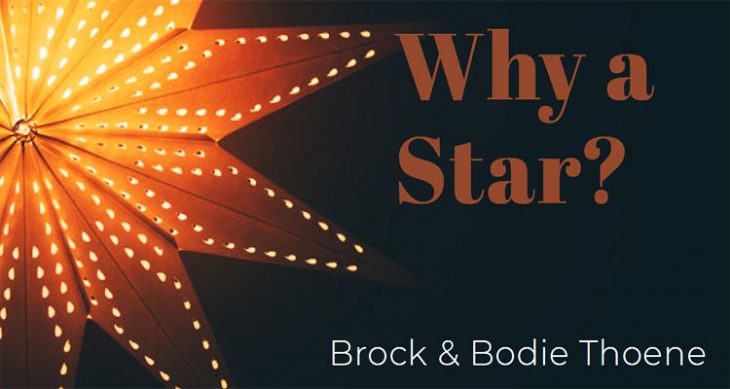[Note: This article was taken with permission from Brock and Bodie Thoene’s book Why a Star. A gifted husband-and-wife writing team, the Thoenes are widely respected for their insightful and biblically accurate historical fiction. They are also avid students of astronomy, as this book demonstrates to the glory of God.]
O star of wonder, star of light,
Star with royal beauty bright,
Westward leading, still proceeding,
Guide us to thy perfect Light.
“We Three Kings of Orient Are”
John Henry Hopkins, Jr., 1857
Next to the Babe in the manger, the Star of Bethlehem is the most evocative symbol of the Christ Child’s birth. The Star is additional confirmation that the baby we celebrate at Christmas was no ordinary child. Apart from being acknowledged by angels and wondered at by shepherds, He was worshipped — that’s the word used in Scripture — by enigmatic men who traveled a great distance to reach Him.
Shepherds spent a lot of time “watching over their flocks by night,” and three thousand years ago the boy-and-future king, David, was no exception. No wonder he could ponder the majesty of God. If the universe is so vast and glorious, how much bigger and more powerful and more wondrous must the Creator of the Universe be? No wonder David could write, “The heavens declare the glory of God” (Psalm 19:1).
When I (Bodie) was a child looking up at the sky with my mother, the thought of the bigness of our heavenly Father and my own smallness sent a chill of awe through me. “Wow,” I exclaimed. “Yes, wow,” she replied. ” ‘Wow, God!’ is another way to say ‘Hollowed be Thy Name.'”
What’s so important about having a light in the sky as an announcement of Jesus’ birth? Let’s investigate the meaning of the word star.
A Glimpse of Wonder
In Hebrew, the word for star is kowkab, spelled Kaf-Vav-Kaf-Bet. According to Strong’s Exhaustive Concordance, kowkab is derived either from a word that means “rolling” (like rolling hills, in reference to the way the stars seem to roll across the sky) or a word that means “burning or blisteringly hot.”
What do those definitions have to do with the Star of Bethlehem? And the birth of Jesus? Neither definition seems to have any spiritual significance. But when you break the word for star into two parts: Kaf-Vav and Kaf-Bet, then wonders come to light!
Kaf-Vav means “piercing, like a window pierces a wall, like an opening into a chamber by which what is outside the chamber may be seen.” The second half of the word, Kaf-Bet, appears related to a high, rounded or arched shape.
Now that makes better sense. Kowkab comes from two words that combine to mean “openings” in a high arch. Of course! A star represents a window into the arch of the sky. It’s an opening from our side of creation through which a glimpse of heaven may be gained.
And there’s much more…
The heavens declare the glory of God; the skies proclaim the work of His hands. Day after day they pour forth speech; night after night they reveal knowledge. There is no speech, they use no words; no sound is heard from them. Yet their voice goes out into all the earth, their words to the ends of the world.
– Psalm 19:1-4 (NIV)
From the time Adam and Eve went their own way, setting their wills in place of God’s, humankind waited for a Redeemer who could repair the broken relationship. Abraham caught a glimpse of that future Deliverer when he was rewarded by God for his faithful obedience. Abraham was told, “I will surely bless you and make your descendants as numerous as the stars in the sky… and through your offspring all the nations on the earth will be blessed” (Genesis 22:17-18, NIV).
Later, the pagan prophet Balaam rightfully prophesied, “I see Him, but not now; I behold Him, but not near; a star shall come out of Jacob; and a scepter shall rise out of Israel” (Numbers 24:17, NIV).
So it’s clear that a miraculous Star would relate to the coming of the Messiah of Israel.
A Heavenly Beacon
Was the Star a completely miraculous occurrence? Some people believe so. To them, the Star is a never-to-be-explained supernatural light that appeared only as a guide to the Magi.
They may be right.
But it is also possible that the Star of Bethlehem had both a natural existence and a supernatural significance. Is it possible other observers saw the Star but did not recognize its meaning?
Does God always work through the supernatural? Or, does He sometimes use nature to accomplish His divine purposes? The answer is an absolute, Yes!
In the book of Genesis, God promised Noah, a godly man, that He would never again destroy the world with a flood. What was the symbol of God’s promise? The rainbow!
A rainbow can be explained as the refraction of light by raindrops. But does that understanding detract from the eternal meaning to which God connected it? Not at all!
For Signs and Seasons
Then God said, “Let there be lights in the expanse of the heavens… and let them be for signs and for seasons… “ Genesis 1:14 (NASB)
The word signs in Genesis 1:14 seems to speak for itself. “Pay attention!” creation shouts. “The evidence of the Creator is all around you.”
But the Hebrew word for season, mowed, implies much more than the sequence Spring, Summer, Fall, Winter. Mowed is derived from a word that means “meet, appoint, summon.” Mowed suggests a divine appointment, a festival, an assembly convened for a specific purpose, and a signal.
In other words, after we get beyond thinking that season refers only to a time of year, we see how God’s revelation regarding His creation includes the word signs. Everything means something!
There’s a definite progression in the heavenly display. Down through the centuries, pagan religions have claimed the signs and garbled the message. But those who look with an expectation of seeing God’s purposes outlined in all of creation are not disappointed.
Consider that among the figures displayed in the sky is a Virgin. Called Virgo among the constellations, she is the celestial embodiment of the prophecy in Isaiah 7:14: “Therefore the Lord Himself will give you a sign: (There’s that word again!) The Virgin will be with child and will give birth to a Son, and will call Him Immanuel” (NIV).
In fact, all of the Gospel is recounted in the progression of figures in the heavens. The image we see as the scorpion was rendered as a serpent in some cultures in the past. Above him in the sky is the figure of Ophiucus, the Snake-Handler. Ophiucus as depicted is about to be stung on the heel by the snake/scorpion. But at the same moment he is in the act of crushing his enemy’s head. What a perfect reflection of Genesis 3:15, where the Lord curses Satan, the Deceiver.
Watching and Waiting
“Nations will come to Your light, and kings to the brightness of Your rising.” – Isaiah 60:3 (NIV)
Matthew records that Magi embarked on a Star-guided quest for the newborn King of the Jews. The word Magi is neither Greek nor Hebrew in origin, but rather Persian, Medean, Babylonian, or Chaldean. In different translations it appears as magician, astrologer, sorcerer, seer, and, most commonly, as Wise Men.
Magi isn’t the same word commonly translated “magician” in Scripture, as when Moses had his encounter with the magicians at Pharoah’s court in Egypt. In Jeremiah 39, the Babylonian title Rab Mag is rendered as high official or Chief Magician. That reference seems to indicate a highly placed royal counselor — hence, a “Wise Man.”
We know that the Wise Men came from the East. Remarkably, Ezra 6:2 mentions the Medean city of Ecbatana as the place where the archives of Persian King Cyrus were located — including his order authorizing the rebuilding of the Temple in Jerusalem. That is the same city where the biblical Queen Esther — who was married to the Persian King Xerxes — is said to be buried. Interestingly, her name means “star!”
So then, the Magi were men wise enough to be court counselors to the Persian/Parthian royalty. They may have been familiar with the writings of the Jewish prophet Daniel (who was a respected counselor in Babylon himself). If the Magi living at the time of Jesus’ birth knew Daniel’s work, they undoubtedly also knew the time of prophetic fulfillment was drawing near.
If the Wise Men calculated from Daniel’s writings (9:25-26) that the time of the Anointed One’s death was less than forty years away, then they knew His birth must be imminent! So when the heavens announced the birth of a new King of the Jews, the Magi were already expecting such a sign and were eager to go seek Him.
So, journey they did! They were led to Bethlehem where they encountered the new, heaven-announced King — one not only to be respected or admired or even obeyed, but One worthy to be worshipped!
Have You Seen His Light?
“The people who walked in darkness have seen a great light; those who dwelt in a land of deep darkness, on them light has shined.” – Isaiah 9:2
So, the appearance of a miraculous vision in the sky led those watching for it to journey to the side of a Baby whom they believed was a newborn King. Even granting all that to be true, what does it have to do with you, living two thousand years later? And why is learning about the Star so important to you today?
Here’s why: because that Child — heralded by angels, sought by shepherds, and worshiped by Wise Men — was God incarnate, Jesus Christ.
The Son of God. The One Who said, “I AM the Way, the Truth, and the Life,” and “No one comes to the Father except by Me.”
Follow the Star of Bethlehem! Not just to the top of a Christmas tree but to the Manger, to the Cross, to the Empty Tomb!
Join the ranks of the Wise Men and Women by bringing Him the most precious of gifts — your life, your trust, your hope. You have nothing to lose, and everything to gain… for all Eternity.








In ancient times stars were regarded as angels and/or the homes of angels. Rev 1: 16-20 describes the seven stars in the hand of Jesus as the angels of the seven churches.
Also, Num 4:17 predicts that a star shall come out of Jacob.
So, the sign of the star for Christianity is that a great angelic being will incarnate into the Jews – we also know it was the second person of the Trinity appearing as an angel as said in Rev 22:18.
What is God saying now?